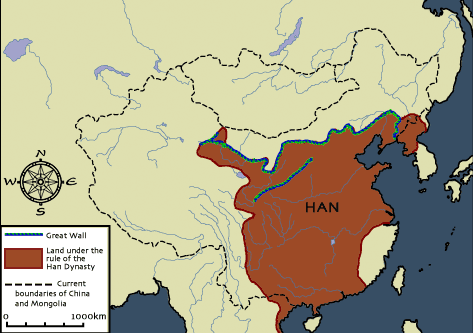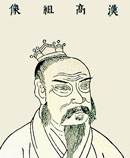Chinese Culture >> Chinese Dynasty >> Han Dynasty
Han Dynasty Background (Year: 207 BC - AD 220)
 The Han dynasty plays a very important role in Chinese history. For starters,
they invented Chinese history as we know it today. Additionally, the
overwhelmingly predominant ethnic group in China is called the Han; they are
named after the dynasty. But, most importantly, they developed (actually, it was
invented by Qin Shihuangdi (Qin Dynasty), but
perfected by the Han) the administrative model which every successive dynasty
would copy, lock, stock, and barrel.
The Han dynasty plays a very important role in Chinese history. For starters,
they invented Chinese history as we know it today. Additionally, the
overwhelmingly predominant ethnic group in China is called the Han; they are
named after the dynasty. But, most importantly, they developed (actually, it was
invented by Qin Shihuangdi (Qin Dynasty), but
perfected by the Han) the administrative model which every successive dynasty
would copy, lock, stock, and barrel.
Why is the development of bureaucracy so important? Well, first of all, because ancient China was a big country. In 206 BC, when Han dynasty was founded, China stretched from modern Shenyang (some 500 km north of Beijing) in the north to around Guilin in the south; from the Pacific in the east to well past Chongqing in the west. Until Russia laid claim to Far East Siberia, China was the largest country in the world. It was also the most populous (60 million people at the time), and still is (however, India will probably overtake China in terms of population some time early in the 21th century). This is a management issue of tremendous proportions. How are you going to do things like collect taxes, keep the peace, and basically run a government without bureaucracy? The Chinese bureaucratic system is based on the study of the Confucian Classics, which provide an ideological reference point for proper behavior (which was often ignored, but it worked well enough) and loyalty to the Emperor. By developing this system, the Han emperors were able to run China with a reasonable degree of efficiency.

During the reign of an emperor named Han Wudi lived a historian named Sima Qian. His most important contribution to Chinese history was that he wrote a book known as Records of the Grand Historian (actually, he claimed to just be completing a book that his father, Sima Tan, had started, but most of the book is Sima Qian's). Most history books are very linear: first you talk about the Greeks, then the Romans, then the Dark Ages, and so on. What Sima did was structure his book so that each chapter covered a different topic: one chapter was a political record of the kings and emperors; the next would cover literature; the third, philosophy, and so on. Every dynastic record that followed copied Sima's original. Actually, there is an English-language history of China that loosely follows this model; it's called China's Imperial Past, written by Charles O. Hucker.
Between AD 8 and 25, a man named Wang Mang ruled China. He had been part of the Han royal household; he himself, however, was a commoner and had no royal blood in his veins. He had been appointed emperor after a power struggle in the Han house. History is mixed on him. While he did seem to have some good, reform-oriented ideas (e.g. power back to the people), he really wasn't up to the task of ruling. After his death in AD 25, the Han royal family took back the reins of power, and set up the Later Han dynasty.
The later Han were able to keep it together for about 200 years; however, towards the end of their rule, they become more and more dissolute. More importantly, they were unable to deal with two factors: a population shift from the Yellow River in the north to the Yangzi in the south; and they simply could not control barbarian tribal raiders from the north, which were one reason why people were moving to the south. Eventually, in AD 220, the center had lost so much control to the provinces that it collapsed (a small rebellion in the north helped), plunging China into 350 years of chaos and disunity.
Click on pictures below to enlarge.
Chinese Dynasty Quick Links
Tang Dynasty Xia DynastyWestern Zhou Dynasty Eastern Zhou Dynasty Shang Dynasty Qin Dynasty Han Dynasty Three Kingdom Dynasty Sui Dynasty Song Dynasty Yuan Dynasty Ming Dynasty Qing Dynasty Early 20th Century China


